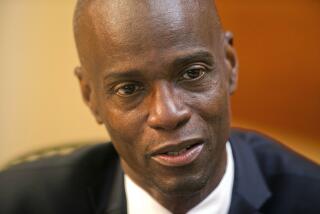French Cover-up Seen in Greenpeace Ship Blast
- Share via
PARIS — Le Monde, France’s most influential newspaper, reported Tuesday that two French frogmen, whose presence in New Zealand waters had been kept secret until now, are believed to be responsible for the bombing and sinking of the Greenpeace ship Rainbow Warrior in New Zealand last July.
Le Monde’s account, if true, would indicate an attempt at a massive cover-up by the government of President Francois Mitterrand.
It would also imply that high officials of the Ministry of Defense, the French intelligence agency and perhaps the president’s office lied to a special investigator who cleared the French government of responsibility in a report issued three weeks ago.
Le Monde said it has been informed by many knowledgeable sources that the five French intelligence agents now under arrest or sought by the New Zealand authorities were accomplices in the crime but did not actually place the mines on the hull of the ship.
Anti-Nuclear Protest
The explosion, which killed a Portuguese-born photographer aboard the ship, prevented the Rainbow Warrior from leading a flotilla of ships to Mururoa Atoll in the South Pacific to protest French nuclear testing there.
According to Le Monde, two other French agents, both trained as frogmen, placed the mines on the vessel and then escaped from New Zealand after the explosion. Bernard Tricot, the special French investigator, evidently was not told about these two agents and did not interview them. He concluded that the French government had sent its agents to New Zealand to spy on the Rainbow Warrior but not to bomb it.
The articles in Le Monde seem to indicate that the French government is getting involved in what it has said it is trying to avoid--what the French press calls a “tricolor Watergate.”
The Defense Ministry, asked to comment on the Le Monde articles, said only that “everything is and will be done to reveal the truth.”
The office of Premier Laurent Fabius issued a statement recalling that Fabius had previously promised that “judicial proceedings will be started if it appears that any criminal acts were committed by French persons.”
The Greenpeace affair has resulted in a good deal of acrimony between France and New Zealand and hardened New Zealand’s opposition to nuclear testing. New Zealand Prime Minister David Lange, in fact, has been scathing in his criticism of the French investigation. The latest Le Monde article is sure to intensify the debate.
Le Monde implicated leading French officials in the bombing. The newspaper, in several articles written by Bertrand Legendre and Edwy Plenel, said its sources believe that Defense Minister Charles Hernu, Gen. Jeannou Lacaze, who was armed forces chief of staff at the time, and Gen. Jean Saulnier, then the military adviser to Mitterrand, either authorized the operation against Greenpeace or seemed to acquiesce in it.
But according to Le Monde, Mitterrand himself did not know about the plan.
Posing as Swiss
Le Monde said that Alain Mafarge and Dominique Prieur, the two agents now under arrest and charged with murder and arson in New Zealand, had been assigned to collect information on Greenpeace and its ships while posing as a Swiss couple touring New Zealand.
Three other agents who were later interviewed in Paris by Tricot for his investigation were assigned to sail on a yacht and supply equipment to the bombers. New Zealand issued arrest warrants for the three, who surrendered to Paris police.
Le Monde’s sources, the newspaper went on, said the two French bombers escaped from New Zealand after the attack, one heading to Australia, the other to New Caledonia.
In its articles, Le Monde did not name its sources but identified them as former agents of the General Directorate of External Security (the French intelligence agency) and people close to the directorate, police following the New Zealand investigation, high-ranking civil servants in sensitive posts, and reserve military officers with close links to the political opposition.
More to Read
Sign up for Essential California
The most important California stories and recommendations in your inbox every morning.
You may occasionally receive promotional content from the Los Angeles Times.













